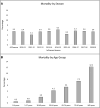The Burden of All-Cause Mortality Following Influenza-Associated Hospitalizations: Influenza Hospitalization Surveillance Network, 2010-2019
- PMID: 39495002
- PMCID: PMC11912969
- DOI: 10.1093/cid/ciae547
The Burden of All-Cause Mortality Following Influenza-Associated Hospitalizations: Influenza Hospitalization Surveillance Network, 2010-2019
Abstract
Background: While the estimated number of US influenza-associated deaths is reported annually, detailed data on the epidemiology of influenza-associated deaths, including the burden of in-hospital vs post-hospital discharge deaths, are limited.
Methods: Using data from the 2010-2011 through 2018-2019 seasons from the Influenza Hospitalization Surveillance Network, we linked cases to death certificates to identify patients who died from any cause during their influenza hospital stay or within 30 days post discharge. We described demographic and clinical characteristics of patients who died in the hospital vs post discharge and characterized locations and causes of death (CODs).
Results: Among 121 390 cases hospitalized with laboratory-confirmed influenza over 9 seasons, 5.5% died; 76% of deaths were in patients aged ≥65 years, 71% were non-Hispanic White, and 34% had 4 or more underlying medical conditions. Among all patients with an influenza-associated hospitalization who died, 48% of deaths occurred after hospital discharge; the median number of days from discharge to death was 9 (interquartile range, 3-19). Post-discharge deaths more often occurred in older patients and among those with underlying medical conditions. Only 37% of patients who died had "influenza" as a COD on their death certificate. Influenza was more frequently listed as a COD among persons who died in the hospital compared with cardiovascular disease among those who died after discharge.
Conclusions: All-cause mortality burden is substantial among patients hospitalized with influenza, with almost 50% of deaths occurring within 30 days after hospital discharge. Surveillance systems should consider capture of post-discharge outcomes to better characterize the impact of influenza on all-cause mortality.
Keywords: cause of death; hospitalization; influenza; mortality; surveillance.
Published by Oxford University Press on behalf of Infectious Diseases Society of America 2024.
Conflict of interest statement
Potential conflicts of interest . R. L. is associate editor for the American Academy of Pediatrics Report of the Committee on Infectious Diseases (Red Book) and was given a fee for this work, which was donated to Minnesota Department of Health. All authors have submitted the ICMJE Form for Disclosure of Potential Conflicts of Interest. Conflicts that the editors consider relevant to the content of the manuscript have been disclosed.
Figures



References
-
- Centers for Disease Control and Prevention . Disease burden of flu. Available at: https://www.cdc.gov/flu-burden/php/about/index.html. Accessed 14 November 2024.
-
- Barker WH, Mullooly JP. Impact of epidemic type A influenza in a defined adult population. Am J Epidemiol 1980; 112:798–811. - PubMed
-
- Mullooly JP, Bridges CB, Thompson WW, et al. . Influenza- and RSV-associated hospitalizations among adults. Vaccine 2007; 25:846–55. - PubMed
Publication types
MeSH terms
Grants and funding
LinkOut - more resources
Full Text Sources
Medical

